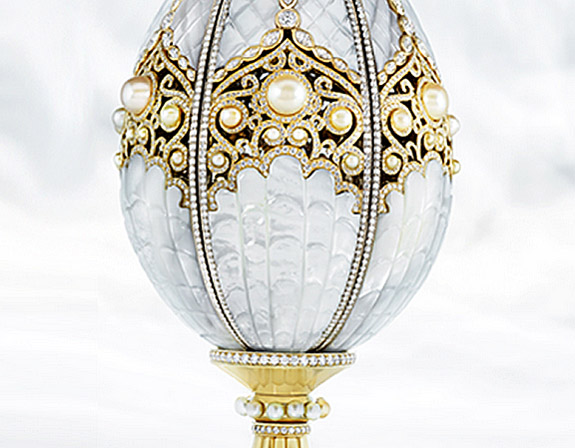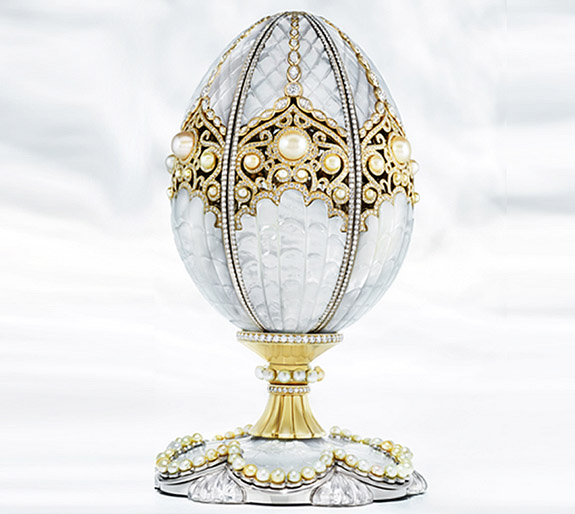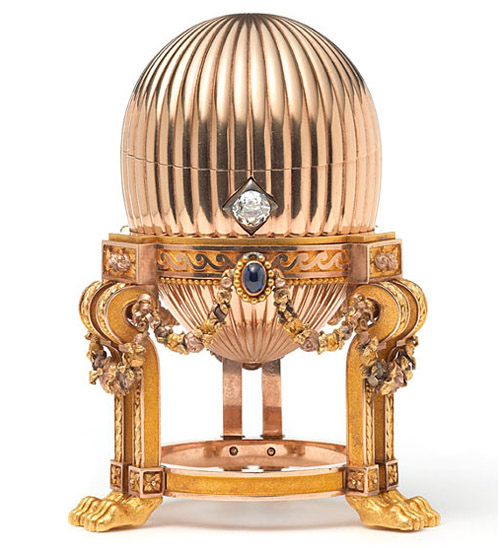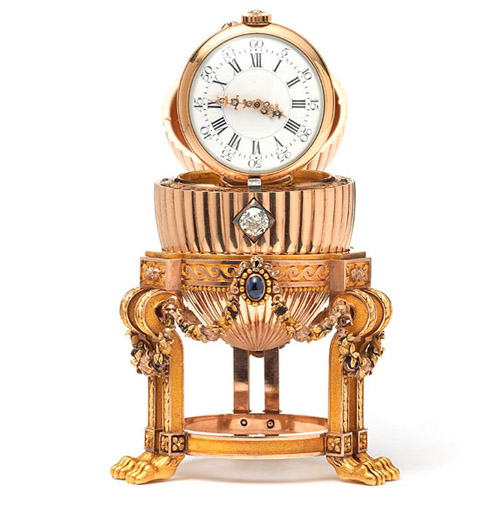March 2nd, 2015
Attendees of the recent Doha Watch and Jewellery Exhibition in Qatar got a first-hand look at Fabergé’s extraordinary $2 million “Pearl Egg,” the first “imperial class” egg released by the design house in nearly 100 years.

Set in white and yellow gold and gleaming with a mother-of-pearl exterior, the egg is adorned with 139 natural white pearls, 3,305 diamonds and carved rock crystal. Mimicking the way an oyster opens to reveal a cultured pearl, the Fabergé egg opens to reveal a unique, 12.17-carat grey natural pearl sourced from the Arabian Gulf.

A special feature of the egg is that its entire outer shell rotates on its base, which simultaneously opens six sections to unveil the tiny treasures inside.
The House of Fabergé collaborated with the Al-Fardan family of world-renowned pearl collectors to design the unique “imperial class” egg — just in time for the forthcoming centenary marking the last Fabergé Imperial Eggs ever delivered. The natural pearls adorning the egg were hand selected by Hussain Ibrahim Al-Fardan from his personal collection.
“I have a passion for natural pearls and it took me many years to build my current collection gathering some of the most extraordinary pearls in the world," said Al-Fardan. "Fabergé has a great history in making jewelry for royalty, and a truly precious Fabergé Egg is a luxury treasure and the symbol of a long-gone era of opulence. This is why I partnered with Fabergé to combine these two traditional treasures: the Fabergé Egg and natural Arabian Gulf pearls, to create an exceptional piece.”
Peter Carl Fabergé and his company designed 50 bejeweled eggs for the Russian Imperial Family from 1885 to 1917. Alexander III and Nicholas II commissioned the most famous “Imperial” eggs as Easter gifts for their wives and mothers. The meticulously crafted objets d’art were produced up until the Russian Revolution, when the Fabergé family fled Russia.

Until last year, eight of the 50 Imperial Easter Eggs had been unaccounted for. Then in March 2014, we learned that a Midwestern scrap metal dealer made the find of a lifetime when he unknowingly scooped up one of the missing Fabergé Imperial Eggs at a flea market for just $14,000.

The buyer’s original intention was to make a quick profit by melting down the egg for its gold content, but he soon realized that he possessed a Fabergé egg that dated back to the late 19th century.
The unnamed scrap dealer sold the egg to an anonymous collector for an undisclosed price, presumed by experts to be upwards of $33 million.
Images: “Pearl Egg” via Faberge; Flea market egg courtesy of Wartski.

Set in white and yellow gold and gleaming with a mother-of-pearl exterior, the egg is adorned with 139 natural white pearls, 3,305 diamonds and carved rock crystal. Mimicking the way an oyster opens to reveal a cultured pearl, the Fabergé egg opens to reveal a unique, 12.17-carat grey natural pearl sourced from the Arabian Gulf.

A special feature of the egg is that its entire outer shell rotates on its base, which simultaneously opens six sections to unveil the tiny treasures inside.
The House of Fabergé collaborated with the Al-Fardan family of world-renowned pearl collectors to design the unique “imperial class” egg — just in time for the forthcoming centenary marking the last Fabergé Imperial Eggs ever delivered. The natural pearls adorning the egg were hand selected by Hussain Ibrahim Al-Fardan from his personal collection.
“I have a passion for natural pearls and it took me many years to build my current collection gathering some of the most extraordinary pearls in the world," said Al-Fardan. "Fabergé has a great history in making jewelry for royalty, and a truly precious Fabergé Egg is a luxury treasure and the symbol of a long-gone era of opulence. This is why I partnered with Fabergé to combine these two traditional treasures: the Fabergé Egg and natural Arabian Gulf pearls, to create an exceptional piece.”
Peter Carl Fabergé and his company designed 50 bejeweled eggs for the Russian Imperial Family from 1885 to 1917. Alexander III and Nicholas II commissioned the most famous “Imperial” eggs as Easter gifts for their wives and mothers. The meticulously crafted objets d’art were produced up until the Russian Revolution, when the Fabergé family fled Russia.

Until last year, eight of the 50 Imperial Easter Eggs had been unaccounted for. Then in March 2014, we learned that a Midwestern scrap metal dealer made the find of a lifetime when he unknowingly scooped up one of the missing Fabergé Imperial Eggs at a flea market for just $14,000.

The buyer’s original intention was to make a quick profit by melting down the egg for its gold content, but he soon realized that he possessed a Fabergé egg that dated back to the late 19th century.
The unnamed scrap dealer sold the egg to an anonymous collector for an undisclosed price, presumed by experts to be upwards of $33 million.
Images: “Pearl Egg” via Faberge; Flea market egg courtesy of Wartski.



